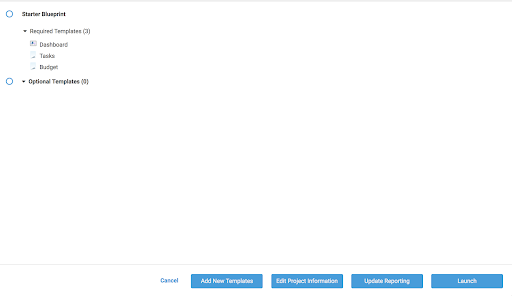Applies to
Smartsheet Control Center: Define and Track Your Project with Project Profile Data
Project profile data (or metadata) is the high level information about all of your projects: it provides a synopsis of the project.
Use project profile data to do the following:
- Define the projectwith values such as Project Name, Description, Owner, Budget, Due Date
- Create status tracking metrics or KPIswith values such as % Complete, Forecast End Date, Project Health
配置文件数据填充顶部的一个总结each project sheet. It can also be displayed on the Project Dashboard, providing a quick project overview. You can even link profile data to the Blueprint Summary or to portfolio-level dashboards.
How to Structure Project Profile Data
Be specific and consistent when you name profile data elements. A profile data element must appear in at least one sheet in the Blueprint though it can appear in multiple sheets.
Profile data is organized under a top-level row (ideally the first row in the sheet) with the word “Summary” in the Primary Column.
Each profile data element is on a separate row indented under the Summary row. Rows indented more than one level are not recognized as profile data.

- Thenamesof the profile data are in the primary column and are indicative of the type of data.
- Thevalueof the profile data is in the column to the right of the name. This should be a text/number column.
Additional columns may contain one of the following:- Data entered directly in the cell–Data may be entered when you create or edit a project, or updated by a collaborator after you create a project.
- Inbound cell link–The value is pulled from a cell on another sheet in the project folder, or from the intake sheet (if the Blueprint is configured for this).
- Formula–A formula uses data in the sheet or across multiple sheets to calculate the value.
You can customize how columns are ordered in Blueprint Settings
Profile Data Summary Guidelines and Best Practices
If you’re wondering whether you should include an element in a profile data summary, here are some questions to ask yourself:
- Does the element provide useful context?
When collaborators are working on multiple projects, a distinctive Project Name or Description can help differentiate each sheet. - Is the element used to calculate a formula elsewhere in the sheet?
For example, you might track remaining budget for a project using the budget provided in the summary section. - Does the element provide high level insight into the state of the project?
Project Health and Forecasted End Date can show you status at a glance.
Here are some best practices for working with profile data:
- Be specific and consistent when you name profile data elements.
- Lock any profile data rows that should not be updated—for example, lock inbound cell links or formulas. (Only the sheet Owner and people shared with Admin-level permissions can lock and unlock rows.)
- Because profile data may appear in multiple sheets, making a change in one sheet does not guarantee it is changed in other sheets. Set up one location where collaborators can update information and have the profile data reference it using a formula or cell link. For example, you might use the Intake Sheet as the source of truth for profile data.
- Provide a place outside the “Summary” section for updates—such as project status verbiage or RYG project health status—and use a formula in the profile data to reference it.
Update Profile Data
To update Intake profile data for a single project:
- In Control Center, select the project you want to update.
- At the bottom of the screen, clickEdit Project Information.

NOTE: Fields that are unavailable (grayed out) must be edited on the Intake Sheet. Editing the Project Name will only change the value in the profile data and won’t change the names of associated sheets, reports, or dashboards.
Manage Profile Data
Profile data fields must be present in source template sheets to be present in a project.
If thevaluewill be filled in when the project is created, it is identified asIntake profile datain the Blueprint Builder. It’s configured with rules on where the data will come from, either manually entered by the Project Creator in the Create Project wizard or automatically filled in with data or a cell link from anIntake Sheet.
TIP: Enter placeholder data in the Intake profile data values (for example, <<$100>>) so you can easily identify errors.
Add Profile Data Fields
You can add profile data fields to source template sheets, change row order, and apply formatting.
IMPORTANT: If the new data fields are Intake profile data or are linked to a Summary Sheet, you must also update the associated Blueprint.
When you add profile data in the Blueprint Builder, it appears in your sheets at the end of the summary section. When you update the Source template through the Blueprint Builder, only new projects will have the additional profile data. (Current projects will not be changed.)
To add new profile data to current projects, not just new projects, seeGlobal Updates: Add profile data.
